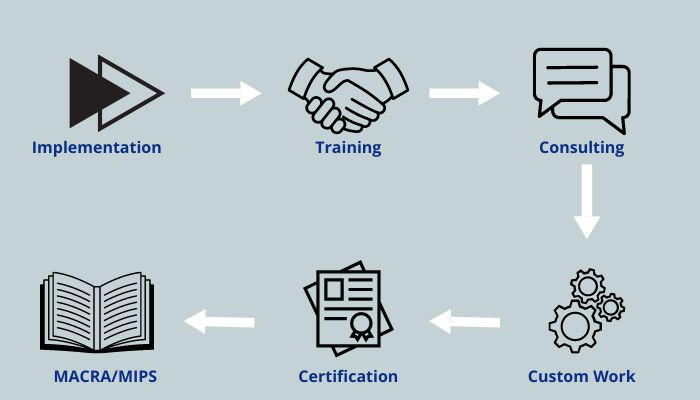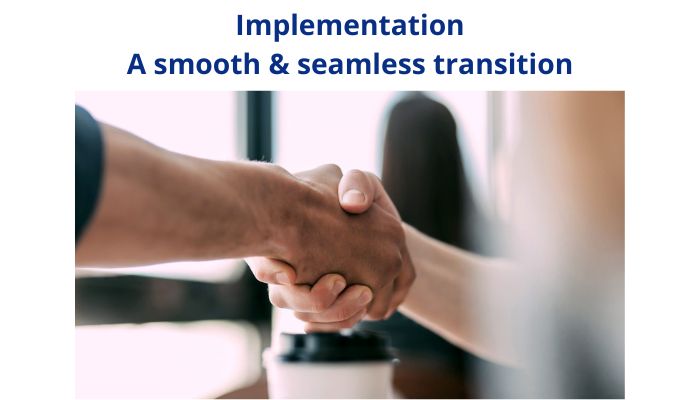Switching to a new healthcare management system is a big step that can greatly improve a medical practice’s efficiency and success. AdvancedMD, a top provider of cloud-based healthcare solutions, offers a well-structured implementation process to ensure a smooth transition and help providers get the most out of its platform. This guide breaks down the AdvancedMD implementation process, covering key stages, best practices, and essential tips to help healthcare providers make the transition seamless and effective.
The AdvancedMD Implementation Approach
AdvancedMD takes a structured, yet flexible approach to implementation, recognizing that each practice has unique needs and challenges. The designers created this process to minimize disruption to daily operations while ensuring that staff is fully prepared to leverage the new system’s full potential.

Key Stages of AdvancedMD Implementation
Discovery and Planning
The implementation process begins with a thorough discovery phase:
- Needs Assessment: AdvancedMD works closely with the practice to understand its specific requirements, workflows, and goals.
- Project Scoping: Based on the assessment, a detailed project plan is developed, outlining timelines, milestones, and resource requirements.
- Team Assignment: A dedicated implementation specialist is assigned to guide the practice through the entire process.
Data Migration
Transferring existing patient data and practice information is a critical step:
- Data Analysis: The AdvancedMD team evaluates the practice’s current data structure and quality.
- Migration Planning: The team develops the TA strategy to ensure accurate and complete data transfer.
- Execution and Validation: The team migrates the data to the new system and then performs thorough validation checks.
System Configuration
Tailoring the AdvancedMD platform to the practice’s specific needs:
- Workflow Customization: The system aligns with the practice’s existing or desired workflows through configuration.
- Template Creation: The system sets up specialty-specific templates for efficient clinical documentation.
- User Setup: The system creates user accounts with appropriate roles and permissions.
Integration
Ensuring seamless communication with other healthcare systems:
- Third-party Integrations: Labs, pharmacies, and other relevant healthcare entities establish connections.
- Hardware Setup: The system integrates any necessary hardware (e.g., scanners, signature pads).
Training
Comprehensive training is provided to ensure staff proficiency:
- Role-based Training: Trainers conduct tailored training sessions for different user roles (e.g., providers, front desk staff, billers).
- Hands-on Practice: Staff members get hands-on experience with the system using real-world scenarios.
- Super User Training: Selected staff members receive advanced training to serve as in-house resources.
Go-Live Support
AdvancedMD provides robust support during the critical go-live phase:
- On-site Support: For larger practices, on-site support may be provided during the initial days of system use.
- Remote Assistance: Dedicated support channels are available for immediate assistance with any issues or questions.
- Performance Monitoring: The implementation team closely monitors system performance and user adoption.
Post-Implementation Follow-up
Ongoing support to ensure long-term success:
- Check-ins: Regular follow-up sessions are scheduled to address any emerging issues or training needs.
- Optimization Recommendations: Based on usage patterns, suggestions are provided for optimizing system utilization.
- Continuous Education: Access to ongoing training resources and updates on new features.

Best Practices for Successful Implementation
- Engage Stakeholders Early: Involve key stakeholders from various departments in the planning process to ensure buy-in and address diverse needs.
- Designate an Internal Project Champion: Appoint a respected team member to lead the implementation effort internally, serving as a liaison with AdvancedMD.
- Prioritize Data Cleaning: Invest time in cleaning and organizing existing data before migration to ensure a smooth transition.
- Embrace Change Management: Develop a change management strategy to help staff adapt to new workflows and technologies.
- Allocate Sufficient Resources: Allocate adequate time and resources for training and adaptation, even if it means temporarily reducing patient loads.
- Leverage AdvancedMD’s Expertise: Take full advantage of the knowledge and experience of the AdvancedMD implementation team.
- Plan for Contingencies: Develop backup plans for critical processes in case of unexpected issues during go-live.
- Encourage Feedback: Create channels for staff to provide feedback on the new system and address concerns promptly.
Challenges and Considerations
While AdvancedMD strives to streamline implementation, practices should anticipate potential challenges.
- Resistance to Change: Some staff members may be resistant to new technologies or workflows.
- Temporary Productivity Dips: There may be a short-term decrease in productivity as staff adapt to the new system.
- Unforeseen Technical Issues: Despite thorough planning, unexpected technical challenges may arise.
- Data Discrepancies: Inconsistencies in legacy data may become apparent during migration.
AdvancedMD’s experienced implementation team is equipped to help practices navigate these challenges effectively.
Measuring Implementation Success
AdvancedMD works with practices to establish key performance indicators (KPIs) to measure the success of the implementation:
- User Adoption Rates
- Patient Satisfaction Scores
- Billing Efficiency Metrics
- Clinical Documentation Time
- Overall Practice Productivity
Regular reviews of these metrics help identify areas for further optimization and ensure the practice is realizing the full benefits of the AdvancedMD platform.
Conclusion
Implementing AdvancedMD is a game-changer for healthcare practices, but success requires careful planning, the right resources, and a commitment to innovation. By following a structured approach and best practices, providers can seamlessly transition, boost efficiency, and maximize the benefits of this powerful healthcare management solution.
But the journey doesn’t stop at implementation. With AdvancedMD’s ongoing support, regular updates, and continuous improvements, practices can adapt to evolving healthcare trends, enhance patient care, and optimize workflows. When done right, AdvancedMD can be the key to transforming your practice, improving efficiency, and delivering exceptional patient experiences.
